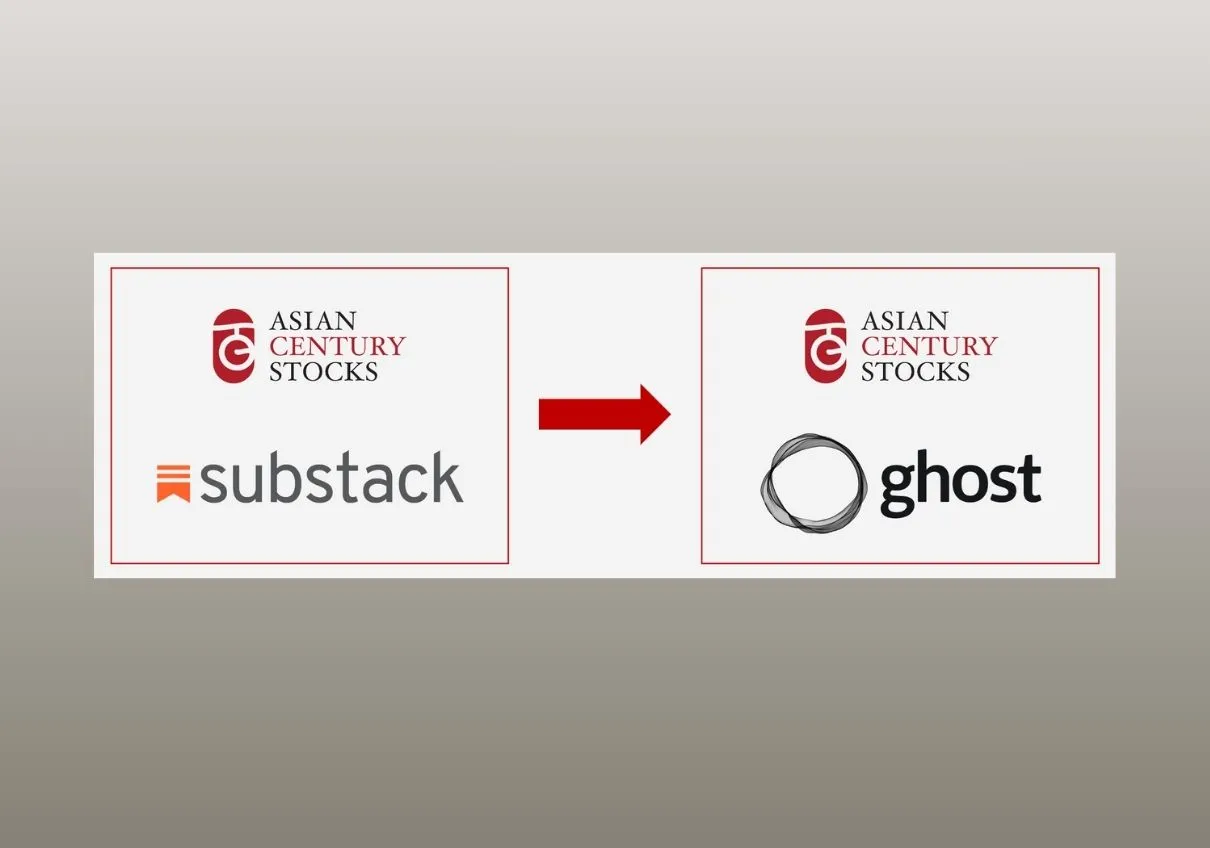Table of Contents
I started Asian Century Stocks in April 2021, more than four years ago.
Since then, it's always been hosted on the Substack platform. The decision to work with Substack has served the publication well, especially in its early years.
But Substack is no longer the best choice for serious publications. So from today onwards, Asian Century Stocks will be hosted on the newsletter platform Ghost.
The truth is at this decision has been years in the making. So let me give you the background story.
Substack's promise
In April 2021, I quit my previous job with the dream of making a living writing about stocks online.
I had played around with a template on Substack and then renamed it Asian Century Stocks to emphasize my focus on Asian equities.
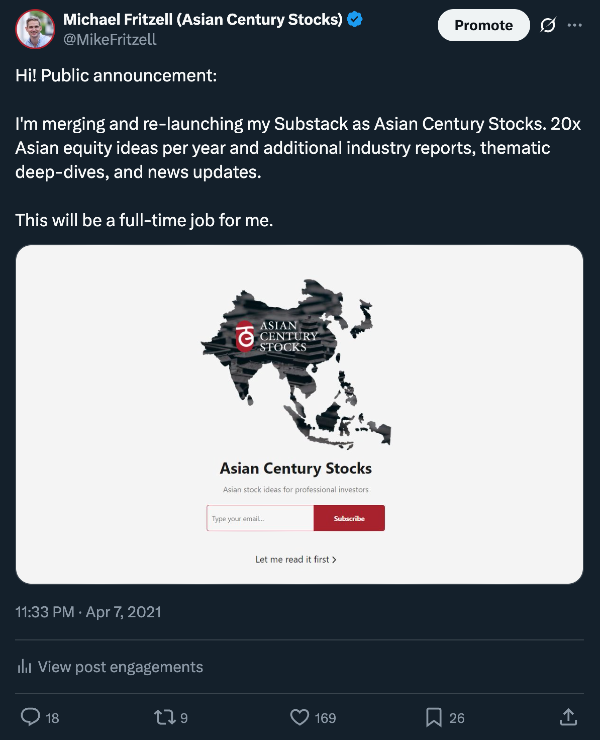
I was excited about Substack. Readers were thirsty for longer-form content after years of scrolling social media feeds. Substack made payments easy. And that meant that you could finally get paid for writing about stocks.
One of the pivotal moments for me was when Jason Calacanis interviewed Substack's founder, Chris Best, on the show "This Week in Startups":
During this interview, Chris expressed a positive view about email marketing and the independence it brings to publishers:
"... the last place where you can have a direct channel with your audience that's not controlled by one of the major like one of those Google Facebook Twitter"
His message resonated with me. I felt that Substack would enable me to form a direct relationship with my readers, without relying on larger platforms like Facebook or Twitter.
Chris promised a future where consumers would be in greater control over what they consume. No longer did we have to rely on social media feeds designed to make you addicted:
"email newsletters and podcasts and especially paid content like this is allowing people to reclaim control of their own attention which has been kind of like voluntarily stolen from them by these algorithmic feeds that they've become addicted to"
I thought that was great. Finally, we could be in control of our own time again.
Finally, Chris argued that with Substack taking a clean 10% of writer revenues, our interests were fully aligned. The only way for Substack to thrive was for its writers to thrive.
Soon after I began writing on Substack, I became one of eleven writers awarded a Substack Fellowship. These fellowships were given to writers based on:
"[the] clarity and insight of their publications, their ability to inspire new writers, and their appetite for community engagement"
The fellowship was incredibly flattering. In addition to US$10,000 in prize money, Substack also helped promote my publication, including through an interview that showed up on one of Substack's main publicity channels. To put it simply, Substack was supportive of its writers.
And I could see the result in the growth of my publication. Within the first year, the number of paid subscribers hit 262, helping the publication reach escape velocity. I could finally afford to pay my rent, using Substack income alone. It was an incredible feeling.

The reality
In 2021, Substack raised US$65 million from a consortium of investors in its Series B funding round. After this capital raise, I noticed a gradual shift in the company's strategy. Substack moved away from championing individual creators towards building a platform of its own.
The first move in this direction was the "Substack Reader" app. This app had a feed of posts in a chronological order, as well as a search function that allowed users to find new publications:
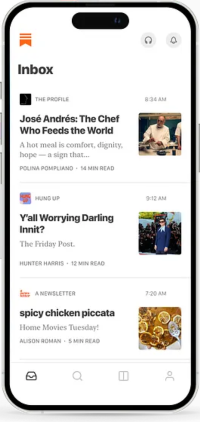
Initially, I thought the Substack app was a great idea. It resolved the issue of emails ending up in Gmail's spam or promotions folders, and it also addressed the issue of emails being cut off due to email size limits.
The app helped publications get discovered by readers who hadn't yet noticed them. And within the app, I could now offer videos and reader polls. Substack promoted the app, stating that creators could now build their own mini media empires – all within the app.
However, the app slowly morphed into something entirely different - becoming more of the type of platform that Chris Best had warned us about in his 2020 interview.
For example, the Substack app soon introduced an algorithmic feed for the publications that readers were subscribed to:
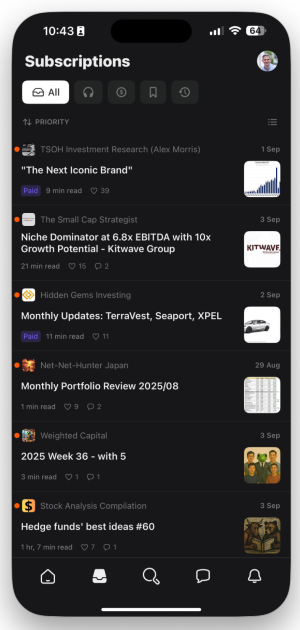
I could no longer rely on the app to actually display the posts I had written for you. Some paid subscribers told me they hadn't seen my posts in months. And so I was forced to write towards the algorithm - guessing what would help my posts reach the top of this new "Priority" inbox feed.
Next came the "Substack Notes" social media feature. It was set up shortly after a public spat with Twitter's Elon Musk, perhaps prompting Substack to realize it needed a social media platform of its own.
In theory, a Twitter clone within the Substack app might help creators get noticed. I found that the loudest voices often took up the most space in the Substack Notes feed. And with the social media feature becoming the default tab in the app, readers paid even less attention to the posts they actually paid for.
Another problem was Substack's "recommendations" feature. This feature allows Asian Century Stocks to recommend other publications. And vice versa.
Substack's platform ambitions were evident here, too. Instead of being a passive feature helping readers find new publications, Substack nudged readers to subscribe to as many publications as possible.
Here's how it works: when you sign up for one publication, Substack will ask you to follow x number of additional people and subscribe to four publications instead of one. Many readers click "Continue" without giving it much thought.
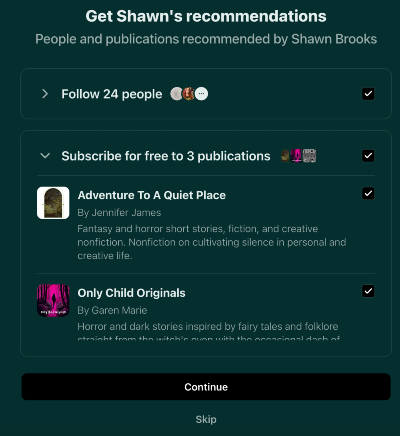
This type of nudging caused our mailing lists to grow rapidly, but readers quickly felt overwhelmed by the number of emails in their inboxes.
In the past, authors would create their own publications and send posts from those. But today, Substack is now pushing authors to publish posts directly from their profiles.
For example, the following author – a brilliant former buy-side analyst – thought she had set up a Substack called "Sector Stories" when in reality, she had just set up a personal profile with that same name. Her publication doesn't have a website, so her articles are "stuck" within the app:
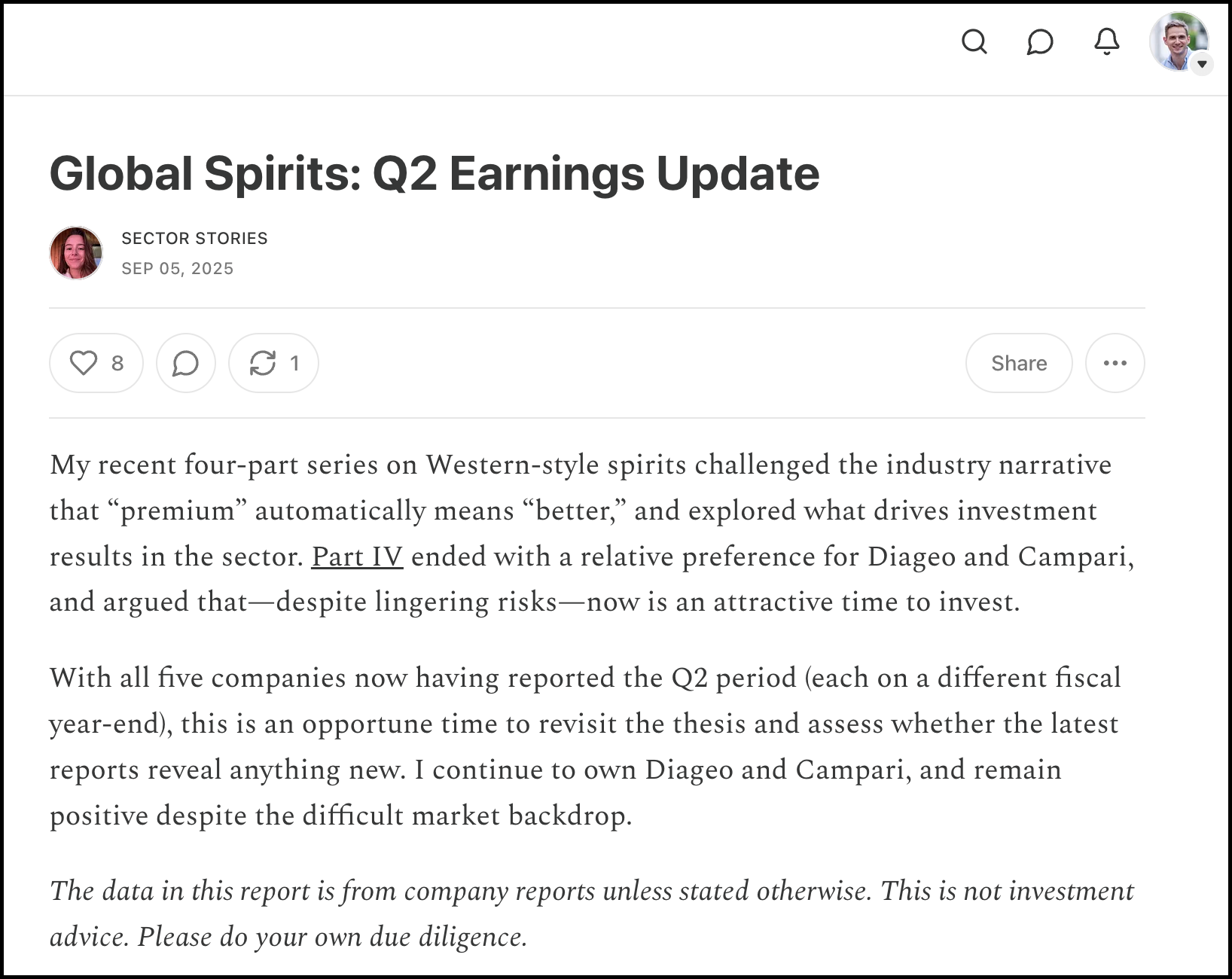
It seems that Substack's vision is to create a platform where readers follow authors, and authors publish posts directly from their profiles. No email is exchanged in the process. Instead, both readers and publishers end up stuck within the Substack ecosystem.
The final straw

On 18 August 2025, Substack announced that it had enabled payments within its app. Readers on the Substack app can now subscribe to any publication within it. Since the payments are made via the iOS App Store, the total fee is now 40%. With a price of US$350/year, Asian Century Stocks would therefore have to raise its price to US$460 to break even.
I asked my Twitter followers how they felt about this set-up, and they almost universally expressed dismay. Why would anyone pay an additional US$110 per year to subscribe via the app instead of using a browser?
What's worse is that if a reader subscribes via the app, I can't issue refunds, cancel the subscription, or transfer it to another platform.
To Substack's credit, the platform is straightforward to use. I love Substack's video capabilities, since they allow me to upload videos with ease. The automated emails provided by "Substack Boost" are excellent, too. And I'm grateful that I've been able to dedicate over 95% of my time on research, which was the whole point of starting a publication in the first place.
However, at this point, it's clear what Substack is trying to do. They want to create the next social media platform, where readers can "follow" and pay writers directly within the app, thereby providing a complete lock-in for publishers on the platform.
These platform ambitions may serve Substack well. But I don't see how I serve my readers well asking them to fork out 40% more for the exact same content as they'd receive in an email. So, I've decided to move back to basics.
The future of Asian Century Stocks

From today onwards, Asian Century Stocks will be on the Ghost platform. This platform was developed by an Englishman called John O'Nolan and a half dozen people at the Ghost Foundation. John is sincere and doesn't have the platform ambitions that Substack has. The Ghost Foundation hasn't taken any venture capital funding, is self-sustaining and completely independent from any of the major platforms. So I think it will be the perfect home for Asian Century Stocks.
Your experience will be almost the same as before:
- The website address remains the same: asiancenturystocks.com.
- The new website has been created by the exceptional Marc Perel and his team at Obox in Cape Town, South Africa. I think it looks great.
- The Ghost platform is blazing fast and, in my view, even more intuitive than Substack's. In fact, Ghost's software is so good that some of Substack's own code was actually copied from Ghost.
- Your subscription is processed through the US payment company Stripe. That has always been the case, even on Substack. So nothing will change on that front.
- From now onwards, you will receive all future posts in your email inbox. They won't show up in Substack's app. If you're having trouble receiving emails from Asian Century Stocks, check your "spam" or "promotions" folders and then drag them over to your inbox to teach your email client that they're not spam.
- My posts will resemble those I created on the Substack platform. And my PowerPoint presentations will be the same as before.
- It will take a few days for all the videos to be uploaded to the new website. So please be patient.
The new website menu now looks like this:

Click "Search" to look through all previous posts. Click "Log In" to view the paid content, and you'll then receive an email with a login link.
Once you're logged in, there will be a button that says "Upgrade", allowing you to become a premium subscriber:

Click the "Profile" button (the outline of a person) at the top right corner of your screen to see your personal account settings, including your subscription details.
The links in the top middle are almost the same as before, except that I've renamed "Home" to "Latest" and "Table of contents" to "Library". Just for simplicity.
I've also added tags to the second column page of the main page. These tags enable you to access posts from specific countries, such as "Japan" or "Hong Kong".

To make sure you are satisfied with my content, every email from Asian Century Stocks will now finish with the following three buttons:

So if you enjoyed a particular post, click "More like this". And if you didn't, click "Less like this". This type of feedback will help me understand what content you enjoy and don't.
Since I will be saving money during the transition (roughly 8% of total revenues), I've signed up for a subscription to the London-based institutional data analytics platform Smart Insider. It's a fantastic service that will allow me to track insider transactions and share buybacks across Asia. I plan to send out monthly posts highlighting the top insider purchases that occurred during a particular month.
I'll continue to write about 20+ companies per year, as well as monthly portfolio updates. I've received feedback that you want to see more thematic reports, more storytelling. So I'll take your advice and write more about general-interest topics.
I've also decided to move the Asian Century Stocks community from Telegram to Slack, as it'll be better suited for everyday chat. I'll be there daily, talking about companies in Asia. You'll get access to the community once you've become a paid subscriber: you can find the link the Slack group here. I will also send out an invite link at 12:00 Singapore time on Thursday 2 October 2025 to all paid subscribers.

I'm grateful for everything that Substack has done for its writers. But it's time to move on. And I think Ghost will be the perfect new home for the publication.
If you're not a premium subscriber yet, I encourage you to take the leap and join the 560 subscribers who are actively supporting the newsletter. You'll get smarter about equities in Asia and receive over 20 deep dives annually. To celebrate the launch, I'm offering you a 20% discount for the first year:
Thank you for trying Asian Century Stocks, and I hope you enjoy the content.
Best regards,
Michael Fritzell

